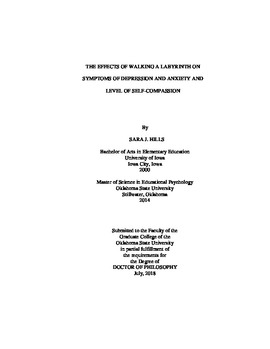| dc.contributor.advisor | Romans, John S. C. | |
| dc.contributor.author | Hills, Sara J. | |
| dc.date.accessioned | 2019-03-20T18:35:42Z | |
| dc.date.available | 2019-03-20T18:35:42Z | |
| dc.date.issued | 2018-07 | |
| dc.identifier.uri | https://hdl.handle.net/11244/317604 | |
| dc.description.abstract | Exercise and meditation have been shown to improve wellness and to help maintain a healthy lifestyle, yet the effects of meditation and movement together have been largely ignored. This current mixed-methods study utilized a convergent independent three-arm design to explore the experiences and benefits of walking a labyrinth, a form of meditative movement (MM), as a complementary treatment for depression and/or anxiety. College students experiencing depression and/or anxiety who were at least 18 years old from a Midwest university were sequentially assigned to one of three groups: treatment (TG), active control (ACG), or wait-list control (WCG). TG and ACG participants completed 20 minute walking sessions once a week for four weeks in either a labyrinth (TG), on a rectangular path (ACG), or in a labyrinth following a wait period (WCG). This study sought to determine if MM in a labyrinth reduced symptoms of anxiety and depression and raised levels of self-compassion. Observation Oriented Modelling (OOM) results from pre- and post-measures of anxiety, depression, and self-compassion suggested participants in the ACG experienced the greatest reduction in symptoms of anxiety and participants in the TG may have seen the greatest increase in level of self-compassion. Phenomenological analysis of journal entries, naturalistic observations, and open-ended questionnaires suggested the vast majority of participants in both the TG and ACG enjoyed their sessions and found them to be peaceful, simple, and a welcome break from the stress of daily life. Four main themes were found in the qualitative data that may help readers to better understand the experiences of the participants: Expectations vs. Openness, Inner and Outer Contexts, Coping Mechanisms, and Distress Tolerance. Discussions of quantitative and qualitative data intersections are explored and future directions for investigating MM in a labyrinth as a complementary treatment are suggested. | |
| dc.format | application/pdf | |
| dc.language | en_US | |
| dc.rights | Copyright is held by the author who has granted the Oklahoma State University Library the non-exclusive right to share this material in its institutional repository. Contact Digital Library Services at lib-dls@okstate.edu or 405-744-9161 for the permission policy on the use, reproduction or distribution of this material. | |
| dc.title | Effects of walking a labyrinth on symptoms of depression and anxiety and level of self-compassion | |
| dc.contributor.committeeMember | Lee, Hang-Shim | |
| dc.contributor.committeeMember | Koch, Julie Mae | |
| dc.contributor.committeeMember | Hammer, Tonya R. | |
| dc.contributor.committeeMember | Mullins, Larry Lee | |
| osu.filename | Hills_okstate_0664D_15813.pdf | |
| osu.accesstype | Open Access | |
| dc.type.genre | Dissertation | |
| dc.type.material | Text | |
| thesis.degree.discipline | Educational Psychology | |
| thesis.degree.grantor | Oklahoma State University | |
